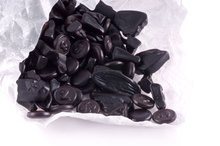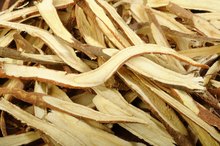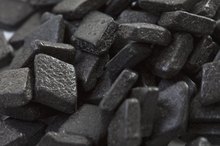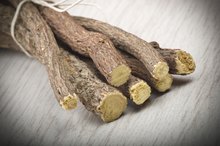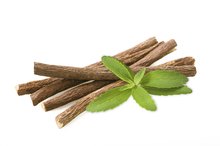Differences Between DGL & Licorice Root
When herbalists talk about licorice, they aren’t referring to the sweet black candy with the same name, although licorice root was the original flavor for the candy. Licorice root, harvested from the licorice, or Glycyrrhiza glabra, plant, is an herbal remedy and food ingredient with thousands of years of use. DGL, or deglycyrrhizinated licorice, is a derivative of licorice root. While both products may be beneficial, do not use them to treat any medical condition unless directed to do so by your doctor. The FDA does not oversee herbal remedies, so quality and safety may vary from one product to the next.
If you are experiencing serious medical symptoms, seek emergency treatment immediately.
Licorice Root and DGL
After drying, herbal manufacturers may grind the hard roots into a powder or make a liquid extraction. The presence of glycyrrhetic acid in licorice root is of concern because it can cause side effects in some. Through a process that removes the acid, called deglycyrrhizination, DGL results, which is still beneficial in treating some conditions. If the product does not contain glycyrrhetic acid, the label will specify “DGL Licorice.”
- After drying, herbal manufacturers may grind the hard roots into a powder or make a liquid extraction.
- The presence of glycyrrhetic acid in licorice root is of concern because it can cause side effects in some.
Potential Internal Benefits
Does Black Licorice Help Induce Labor
Learn More
Clinical studies confirming these benefits are lacking, however.
Potential External Benefits
Considerations
Side Effects of Deglycyrrhizinated Licorice
Learn More
The “PDR” lists chronic hepatitis, cirrhosis of the liver, renal disorders, high blood pressure and a rapid heartbeat as potentially dangerous side effects associated with taking regular licorice. The risk of side effects increases with overdosing. Do not give licorice root to those who suffer from heart disease, fluid retention, kidney or liver disorders, diabetes or elevated blood pressure. In addition, do not give licorice root to pregnant women and nursing mothers, unless directed to do so by a doctor. Talk to your doctor about the potential interference of licorice products, including DGL, with any current medications you’re taking.
- The “PDR” lists chronic hepatitis, cirrhosis of the liver, renal disorders, high blood pressure and a rapid heartbeat as potentially dangerous side effects associated with taking regular licorice.
- Do not give licorice root to those who suffer from heart disease, fluid retention, kidney or liver disorders, diabetes or elevated blood pressure.
Related Articles
References
- University of Maryland Medical Center: Licorice
- “PDR for Herbal Medicines, Second Edition”; Joerg Gruenwald, Ph.D.; 2000
- “Gale Encyclopedia of Alternative Medicine, Volume 2”; Jacqueline L. Longe; 2005
- NIH National Center for Complementary and Integrative Health. Licorice root. Updated December 1, 2016.
- Raveendra KR, Jayachandra, Srinivasa V, et al. An extract of glycyrrhiza glabra (GutGard)alleviates symptoms of functional dyspepsia: a randomized, double-blind, placebo-controlled study. Evidence-Based Complementary and Alternative Medicine. 2012;2012:1-9. doi:10.1155/2012/216970
- Messier C, Epifano F, Genovese S, Grenier D. Licorice and its potential beneficial effects in common oro-dental diseases. Oral Dis. 2012;18(1):32-39. doi:10.1111/j.1601-0825.2011.01842.x
- Shi Q, Hou Y, Yang Y, Bai G. Protective effects of glycyrrhizin against β2-adrenergic receptor agonist-induced receptor internalization and cell apoptosis. Biol. Pharm. Bull. 2011;34(5):609-617. doi:10.1248/bpb.34.609
- Tsao S, Yin M. Antioxidative and antiinflammatory activities of asiatic acid, glycyrrhizic Acid, and oleanolic acid in human bronchial epithelial cells. J. Agric. Food Chem. 2015;63(12):3196-3204.
- Zhao H, Zhang X, Chen X, et al. Isoliquiritigenin, a flavonoid from licorice, blocks M2 macrophage polarization in colitis-associated tumorigenesis through downregulating PGE2 and IL-6. Toxicology and Applied Pharmacology. 2014;279(3):311-321. doi:10.1016/j.taap.2014.07.001
- Nahidi F, Zare E, Mojab F, Alavi-Majd H. Effects of licorice on relief and recurrence of menopausal hot flashes. Iranian Journal of Pharmaceutical Research: IJPR. 2012;11(2):541-8.
- Hajiaghamohammadi AA, Zargar A, Oveisi S, Samimi R, Reisian S. To evaluate of the effect of adding licorice to the standard treatment regimen of helicobacter pylori. The Brazilian Journal of Infectious Diseases. 2016;20(6):534-538. doi: 10.1016/j.bjid.2016.07.015
- Irani M, Sarmadi M, Bernard F, Ebrahimi Pour GH, Shaker Bazarnov H. Leaves antimicrobial activity of Glycyrrhiza glabra L. Iranian Journal of Pharmaceutical Research: IJPR. 2010;9(4):425-8.
- Penn State Hershey Milton S. Hershey Medical Center. Licorice.
- Omar HR, Komarova I, El-Ghonemi M, et al. Licorice abuse: time to send a warning message. Therapeutic Advances in Endocrinology. 2012;3(4):125-138. doi:10.1177/2042018812454322
- Räikkönen K, Martikainen S, Pesonen A, et al. Maternal licorice consumption during pregnancy and pubertal, cognitive, and psychiatric outcomes in children. Am J Epidemiol. 2017;185(5):317-328. doi:10.1093/aje/kww172
- Consumer Reports. Food and drug interactions you need to know about. Updated November 4, 2018.
- Winchester Hospital. Library. Updated April 11, 2011.
- Consumer Reports. How to choose supplements wisely. Updated October 30, 2019.
- FDA. Black licorice: Trick or treat? Updated November 6, 2017.
Writer Bio
Glenda Taylor is a contractor and a full-time writer specializing in construction writing. She also enjoys writing business and finance, food and drink and pet-related articles. Her education includes marketing and a bachelor's degree in journalism from the University of Kansas.
